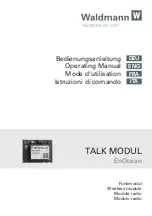
8 - 2
WiNG 5.7.1 Access Point System Reference Guide
8.1 Wireless Firewall
A firewall enforces access control, and is considered a first line of defense in protecting proprietary information within the
access point managed network. The means by which this is accomplished varies, but in principle firewalls are mechanisms that
block and permit data traffic within the network. Firewalls implement uniquely defined access control policies, so if you do not
have an idea of what kind of access to allow or deny, a firewall is of little value, and in fact could provide a false sense of
security.
With our access points, firewalls are configured to protect against unauthenticated logins from outside the network. This helps
prevent hackers from accessing wireless clients within the network. Well designed firewalls block traffic from outside the
network, but permit authorized users to communicate freely outside the network.
Firewalls can be implemented in both hardware and software, or a combination of both. All traffic entering or leaving the
network passes through the firewall, which examines each message and blocks those not meeting the defined security criteria
(rules).
Firewall rules define traffic permitted or denied within the network. Rules are processed by a firewall device from first to last.
When a rule matches the network traffic processed by an access point, the firewall uses that rule's action to determine whether
traffic is allowed or denied.
Rules comprise of conditions and actions. A condition describes a packet traffic stream. A condition defines constraints on the
source and destination devices, the service (for example, protocols and ports), and the incoming interface. An action describes
what should occur to packets matching set conditions. For example, if a packet stream meets all conditions, traffic is permitted,
authenticated and sent to the destination device.
Additionally, IP and MAC rule based firewall filtering can be deployed to apply firewall policies to traffic being bridged by
radios. IP and MAC filtering can be employed to permit or restrict traffic exchanged between hosts, hosts residing on separate
WLANs or hosts forwarding traffic to wired devices.
For more information, refer to the following:
•
Defining a Firewall Configuration
•
•
Configuring MAC Firewall Rules
8.1.1 Defining a Firewall Configuration
To configure a firewall:
1. Select
Configuration
tab from the Web user interface.
2. Select
Security.
3. Select
Wireless Firewall
to display existing firewall policies.
The
Wireless Firewall
screen lists
Denial of Service
,
Storm Control
and
Advanced Setting
tabs used to create the single
Firewall policy used by the access point and its connected devices. The
Denial of Service
tab displays be default.
Summary of Contents for WiNG 5.7.1
Page 1: ...WiNG 5 7 1 ACCESS POINT SYSTEM REFERENCE GUIDE ...
Page 2: ......
Page 3: ...WING 5 7 1 ACCESS POINT SYSTEM REFERENCE GUIDE MN001977A01 Revision A April 2015 ...
Page 4: ...ii WiNG 5 7 1 Access Point System Reference Guide ...
Page 24: ...1 4 WiNG 5 7 1 Access Point System Reference Guide ...
Page 36: ...2 12 WiNG 5 7 1 Access Point System Reference Guide ...
Page 72: ...3 36 WiNG 5 7 1 Access Point System Reference Guide ...
Page 470: ...5 386 WiNG 5 7 1 Access Point System Reference Guide ...
Page 472: ...6 2 WiNG 5 7 1 Access Point System Reference Guide Figure 6 1 Configuration Wireless menu ...
Page 624: ...7 46 WiNG 5 7 1 Access Point System Reference Guide ...
Page 724: ...9 56 WiNG 5 7 1 Access Point System Reference Guide ...
Page 783: ...12 35 Figure 12 46 Device Summary screen 4 Click File Management ...
Page 816: ...12 68 WiNG 5 7 1 Access Point System Reference Guide ...
Page 1006: ...13 190 WiNG 5 7 1 Access Point System Reference Guide ...
Page 1026: ...14 20 WiNG 5 7 1 Access Point System Reference Guide ...
Page 1028: ...A 2 WiNG 5 7 1 Access Point System Reference Guide ...
Page 1089: ......
Page 1090: ...MN001977A01 Revision A April 2015 ...
















































